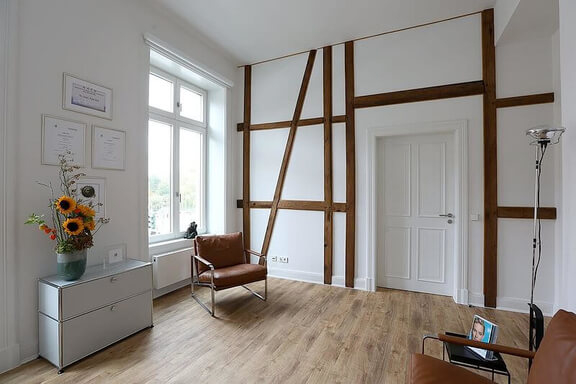The most frequent cause of poor nasal breathing
A great many people suffer from impaired nasal breathing. This can occur for a number of reasons, but deviation of the nasal septum is by far the most common. “Deviated” septum, this is called, often occur in combination with enlarged turbinates (spongy tissue inside the nose). Airflow through the nose is impeded by either of these conditions on its own and can also occur as a combination of the two.
This leads to functional disorders (see below) and leaves patients suffering from a whole range of symptoms. Many people do not even know that their problems - for example: headaches; poor, non-restorative sleep; snoring; daytime fatigue; concentration problems; learning difficulties; susceptibility to infections; inflammation of the throat or tonsils; and many others - are linked to a deviated septum.
In other words, the importance of the septum cannot be overestimated.
This is true with regard to medical surgeries on the inside of the nose, but also for cosmetic surgeries on the outside of the nose (rhinoplasty, or corrective nasal surgery). After all, the nose includes not only the two visible outer walls, but also a third inner wall - the septum. And in many corrective surgeries on the outer nose, it is absolutely essential to straighten that septum as well.
SPECIAL CONSIDERATIONS REGARDING THE NASAL SEPTUM
A crooked septum is no minor issue. This “deviation,” as it is called, causes massive changes in the flow of air through the nose, leading to improper biomechanical stress on the sensitive nasal mucosa.
Many people do not notice this at first, or they assume their symptoms are caused by something else. Over the years, however, it can cause pathological changes in the nasal mucosa and thus lead to a whole spectrum of functional disorders and illnesses.
These can include, among others: nasal breathing problems, desiccation of the nose with bothersome crusting and nosebleeds, uncontrolled runny nose, disturbances of smell and taste, susceptibility to infection, throat or tonsil infections, sinus problems, or pulmonary or bronchial diseases.
Other issues that can impede day-to-day activities include: Headaches; poor, non-restorative sleep; snoring; daytime fatigue; learning disabilities; and many others.
CHONDROPLASTIC SEPTOPLASTY – THE RIGHT TECHNIQUE MAKES THE DIFFERENCE
A very, very large number of people have a deviated nasal septum. When this issue has health consequences (e.g., impairs nasal breathing), it should be surgically corrected (septoplasty).
Corrective surgeries on the outer nose should take care of the inside of the nose at the same time (combined rhinoseptoplasty) in order to ensure the best possible results.
The important thing for patients to know is that there are major differences among the techniques used to straighten the nasal septum:
Procedures using conventional techniques are quick and easy to perform, but only roughly adjust the bent bones and cartilage, or even simply remove them from the septum. Oftentimes, this does not take care of the tensile forces on the cartilage that caused the deviation in the first place. This explains why many people’s septa are still crooked after such operations, occasionally even more crooked than before the operation. And that is the reason why we do not use those techniques.
Instead, we rely on cartilage-reshaping techniques (known as “chondroplastic septoplasty”) to straighten the septum. Such procedures undoubtedly take a great deal more time and effort to perform, but they are worth it.
In our surgeries, we start by reshaping the bended cartilage in a targeted way until the tensile forces that caused it to bend have been neutralized. This allows us to straighten the cartilage much more effectively - and equally importantly, it ensures that without tension the cartilage will remain in its new position.
Next, we stabilize the freshly straightened septum using special absorbable internal stitches. This gives the nose additional stability and also allows us to do our surgery without the painful nasal packing altogether. Click here for more information related to nasal operations without nasal packing. Of course, depending on the type and severity of the septal deviation, we may also resort to other special surgical techniques: for example, septal buttons, extracorporeal septoplastic reconstruction, mucosal sliding, etc. These procedures are essential in revision surgeries on previously operated septa, and especially for operations to plug holes in the septum (“septal perforations”). Click here for more information related to septal perforation.
NASAL SURGERY WITHOUT NASAL PACKING
We can perform corrective rhinoplastic and septoplastic operations without needing nasal packing.
This is possible thanks to our “chondroplastic” nasal surgical technique that we use (sophisticated reshaping of the nasal cartilage, rather than resection). Used in combination with certain special internal stitches, this surgical method offers far superior stabilization during the post-operative healing phase.
On top of that, this procedure is also much more pleasant, because not needing nasal packing means we can save our patients the associated pain and thus make the post-operative period a great deal easier for them.
Also pleasant: our internal stitches are self-resorbing and do not need to be taken out.
Click here for more information related to corrective nasal surgery without nasal packing.
TURBINATES
Crookedness (deviation) of the nasal septum often occurs in combination with enlargement of the turbinates (hyperplasia). Airflow through the nose is impeded by either of these conditions on its own, to say nothing of the two in combination.
This is why, when operating on the septum, many surgeons will routinely reduce the turbinates (spongy tissue inside the nose). Oftentimes, they simply cut off and remove parts of the turbinates, in the hopes that this will ensure improved nasal breathing one way or another.
If not carefully considered, however, turbinate reductions can have long-term adverse consequences: reducing the functional mucosal surface area too dramatically prevents the nose from properly doing its important job of climatizing the air we breathe. Increasing dryness of the nose can lead to a sensation of tension, bothersome crusting, nosebleeds, or even an irreparable condition called rhinitis sicca that involves chronically dry nose and unpleasant smells.
This is why we do not perform turbinate reductions as a matter of routine. We examine each individual patient’s turbinates carefully. Normally shaped, non-enlarged turbinates do not need to be reduced.
That is because turbinates adapt to the conditions inside the nose, so successfully straightening the septum causes slightly enlarged turbinates to heal on their own, with no surgery necessary.
If a patient’s turbinates are indeed significantly enlarged, we reduce them surgically. Depending on the type of enlargement at hand, we have a number of different techniques at our disposal, including (among other things) radiofrequency turbinate reduction. Such techniques allow us to preserve superficial functional mucosa to the greatest possible extent, while performing targeted reduction of the spongy tissue inside the turbinates, or reducing overly large bony sections using special techniques that also preserve the mucosa.
TREATMENT PROCESS
Proper medical treatment requires solid knowledge and extensive experience. Optimum treatment processes also require sufficient time.
And we take that time for you. Our practice in Hamburg always schedules generous amounts of time in for each treatment, so that we can ensure that we are not under time pressure with any of our patients.
This is one reason why our consultations are divided up into two separate appointments. In your first appointment, we will discuss your wishes, and talk you about possible treatments and their limitations.
Should you decide to undergo surgery/treatment, we will go over the essentials with you again during the second consultation (also called the surgery planning meeting). Our surgical and anesthesia teams will help you prepare for surgery in order to ensure your safety.
After treatment, our experienced surgical team or night team will personally take care of you. You will receive important information and patient guides on post-surgical care, and we will work with you directly to set up additional examination or treatment appointments.
CORRECTIVE SEPTOPLASTY BY A SPECIALIST
Dr. Arlt has two medical specialist qualifications: one as a plastic surgeon; the other as an otolaryngologist additionally specialized in cosmetic operations, special head and neck surgeries, and allergology. His Hamburg-based practice is specialized exclusively in the face.
His personal specialties are nasal surgery (functional and aesthetic) and secondary rhinoplasty (revisions and follow-up procedures on patients who have previously undergone surgery),
So we perform an accordingly large number of corrective nasal procedures at our practice in Hamburg. More than half of the procedures we perform are revisions on patients who have already undergone surgery elsewhere.
First-time nasal operations (primary rhinoplasty) should/must combine functional and aesthetic corrections into one procedure. Follow-up nasal operations (secondary rhinoplasty) involve special surgical techniques, and thus require a reconstructive nasal surgeon with particular experience in this area. Corrective rhinoplasty is a job for specialists. Dr. Arlt’s specialist certifications in both plastic surgery and ENT medicine lay a perfect foundation for this specialization; his more than 25 years of experience and mastery of modern, structure-preserving surgical techniques round out the package.
Click here for more information related to primary corrective rhinoplasty.
Click here for more information related to secondary (revision) rhinoplasty.
Contact
Dr. Axel Arlt
Practice community
Esplanade 31 / Ecke Stephansplatz
D - 20354 Hamburg
Phone: +49 (0)40 - 413 55 66 9
Mail: info@dr-axel-arlt.de


